St Mary’s Abbey
Published in Early Modern History (1500–1700), General, Issue 5 (Sept/Oct 2011), Medieval History (pre-1500), Reviews, Volume 19
The chapter house during restoration—and after (opposite page), featuring the east window.
The expression ‘hidden gem’ is so overused as to be almost valueless but it can be properly applied to St Mary’s Abbey. It really is hidden up a small lane off Capel Street in Dublin. Most of the people living thereabouts, never mind in Dublin as a whole, hardly know of its existence, yet it is the last remains of what was once a huge monastery and the origin of the city’s north side.The original abbey was founded by the French Cistercian order of monks in 1147 on an older Benedictine foundation and it soon became the richest religious house in Ireland. The abbey was a centre not just of prayer and charitable work but also of agricultural production. Unusually, it was founded not in a remote site but across the Liffey from Dublin, which provided a ready market for the produce of the abbey’s many farms and encouraged markets to grow in the vicinity. It was a major and influential presence, where many important events took place. It was for a long time the seat of royal government and the repository for state records and treasures. It was in the chapter house, used as the meeting place for the king’s council, that ‘Silken’ Thomas Fitzgerald renounced his allegiance to Henry VIII and so started his ill-fated rebellion. With the introduction of the Reformation, Henry VIII dissolved the abbey in 1539 and then divided its lands among the king’s men.Although the names of the surrounding streets commemorate its existence, all that can be seen today are the chapter house and an adjoining passage. To find this follow the Luas tracks west across Capel (from the Latin capella, a chapel) Street into Mary’s Abbey and take the first right up a small lane. On the right-hand side of this is the entrance to the OPW site. The floor of the chapter house is about 2m below the present street level, so you are passing through 800 years of history as you descend the steps to the floor below.
 You are now in a vaulted chamber where the monks gathered each day to hear a chapter of the rules of the order being read aloud. It consists of four bays separated by a ribbed ceiling. This may not seem much but considering its age and the fact that it has survived the centuries it is remarkable. From the plasterwork of the ceiling to the sandstone ribs, there is much to consider about the design and construction of this room. It tells us about the architecture not just of the Cistercians but also of medieval Ireland. For example, the sandstone ribs are the earliest such in the country.It is essentially a self-guided tour (although a guide may be arranged for groups) and the large information panels tell the story of the abbey and its aftermath. After the Reformation it was no longer a sacred house and so its masonry was quarried for building material to satisfy the growing city’s demands. Grattan (formerly Essex) Bridge, for example, was built from the abbey’s stones. What was not quarried became lost when the site was redeveloped by Sir Humphrey Jervis in the seventeenth century. The chapter house was rediscovered in the eighteenth century and was used as a potato and grain store until it eventually came into state care in 1940.
You are now in a vaulted chamber where the monks gathered each day to hear a chapter of the rules of the order being read aloud. It consists of four bays separated by a ribbed ceiling. This may not seem much but considering its age and the fact that it has survived the centuries it is remarkable. From the plasterwork of the ceiling to the sandstone ribs, there is much to consider about the design and construction of this room. It tells us about the architecture not just of the Cistercians but also of medieval Ireland. For example, the sandstone ribs are the earliest such in the country.It is essentially a self-guided tour (although a guide may be arranged for groups) and the large information panels tell the story of the abbey and its aftermath. After the Reformation it was no longer a sacred house and so its masonry was quarried for building material to satisfy the growing city’s demands. Grattan (formerly Essex) Bridge, for example, was built from the abbey’s stones. What was not quarried became lost when the site was redeveloped by Sir Humphrey Jervis in the seventeenth century. The chapter house was rediscovered in the eighteenth century and was used as a potato and grain store until it eventually came into state care in 1940.

The OPW has carried out a sensitive conservation job. There has been no attempt to reb
The OPW has carried out a sensitive conservation job. There has been no attempt to rebuild what is not there, but the existing stone and plasterwork have been preserved. Some masonry features recovered nearby are on display, and approximations of the three lancet windows on the now subterranean east wall give an idea of what the originals would have looked like. As the Cistercians eschewed colour and ostentation, the glass is grey and plain, unlike the stained glass we associate with medieval institutions. An exception in the chapter house was the ornate statue of St Mary, known as Our Lady of Dublin, the order’s patron. The original statue is in the Carmelite church in Whitefriar Street, where it was placed by Fr Spratt in 1835 after he rescued it from use as a pig trough. An exact replica occupies its alcove in the chapter house.There is a lot of detailed and interesting information on the panels about St Mary’s in particular and the Cistercian order in Ireland in general. For example, the abbey had a large number of lay as well as religious brothers. To become a lay monk was the medieval equivalent of getting a permanent and pensionable job. Lay brothers worked the abbey’s farms and mills in return for food and shelter and, most importantly of all, guaranteed care in old age, which was a rarity in medieval Europe.Going up some steps you come to the slype. This is the corridor that linked the cloisters to the outside. In some abbeys it also served as a parlour for the abbot. It is similar in appearance to the chapter house but smaller. In here there are a few display cabinets with archaeological remains associated with the abbey and other Cistercian houses in Ireland—pieces of pottery, tiles and statues. Here too maps give an indication of the abbey through the centuries and how it was eventually incorporated into the city.The fascinating thing about St Mary’s is that it was built to a standard plan. All Cistercian houses followed the order’s master plan, so that by superimposing it onto the present chapter house archaeologists can determine the footprint of the medieval abbey below the present streetscape. Apart from some amateur and accidental discoveries, no organised excavation has been carried out in the area that the abbey would have occupied. That leaves open the tantalising prospect that 2m beneath Capel Street, Mary Street Little or Meeting House Lane there could still be extensive remains of the abbey’s chapel, cloisters or some other building just waiting to be discovered. HI
















